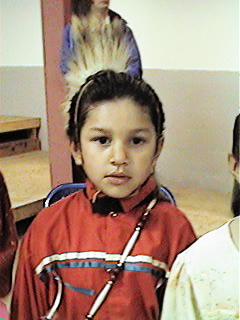 The
Caddo were farmers who lived in East Texas. There were two main groups
of the Caddo in Texas. One major Caddo tribe was the Kadohadacho. The Kadohadacho
lived in large villages along the Red river near the present day Oklahoma
- Arkansas border. The other was the Tejas or Hasinais Caddo who lived
around present day Nacogdoches. In fact, modern Nacogdoches is built on
top of one of the largest of the old Hasinai villages.
The
Caddo were farmers who lived in East Texas. There were two main groups
of the Caddo in Texas. One major Caddo tribe was the Kadohadacho. The Kadohadacho
lived in large villages along the Red river near the present day Oklahoma
- Arkansas border. The other was the Tejas or Hasinais Caddo who lived
around present day Nacogdoches. In fact, modern Nacogdoches is built on
top of one of the largest of the old Hasinai villages.
The Hasinai were made
up of several tribes organized into a confederacy. They called the confederacy
the Tejas. Tejas is the Spanish spelling of the Caddo word and it is pronounced
Te-haas. Sound familiar? TEXAS!!! Yup, Texas is a Caddoan word. It means
"those who are friends". The Tejas Caddo tribes were all "friends".
The Kadohadache seem
to have been one large tribe. They had a main village were the paramount
chief lived and a number of satellite villages up and down the Red river.
There are a number of
closely related tribes who also speak versions of the Caddo language. The
Wichita, and the Pawnee are two important tribes who speak a form of Caddoan.
If this confuses you, think of English. The English speak English, and
so do Americans, Canadians and Australians. A long time ago the Caddos,
the Pawnee and the Wichita were all in the same tribe. They
divided up and moved apart long ago. Their myths claim they all came out
of Arkansas and this is very possible.
WHERE THEY LIVED,
The Caddo lived in
east Texas in the piney forests. Look at the map of East
Texas Indian lands. Their territory extended into Louisiana.
Arkansas and Oklahoma. This region has a good annual rainfall and is in
a temperate region. This is a good climate for farming. There are many
springs, creeks, streams and several large rivers in this area. There are
also many large and small lakes, along with some large swamps. Although
pine trees are the most common trees found here, there are many other kinds
of trees growing in the piney woods. Along the river bottoms there are
many hardwood trees such as oak, walnut, pecan and a tree called bois de
arc. The pecan and walnut trees provided good nuts to eat along with their
wood. The bois de arc is an important tree to the Caddo. It has a strong
and flexible wood. Because it is so strong and flexible it is perfect for
making bows for shooting arrows. Bows and arrows were the favorite weapon
for hunting and for war. The bois de arc only grows in this region, so
the Caddo had all the bois de arc wood. They didn't just make bows for
themselves. They made bows to trade with other Indian tribes who did not
have bois de arc wood.
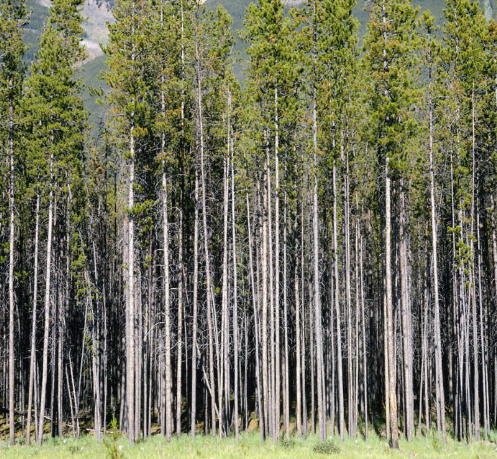
Pine forest
Because they lived in
the woods they used wood for many things. To cut down trees they used stone
axes. Here is a stone axe. These were not very sharp and cutting down a
tree took a long time and a lot of work.
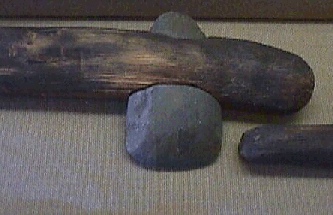
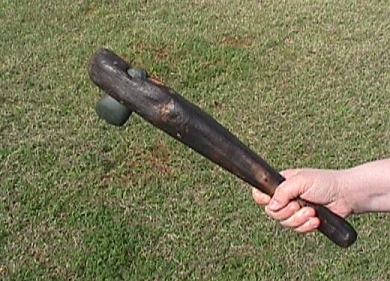
Lisa Bennett holding
a Caddo stone axe.
HOUSES
The Caddo lived in
tall cone shaped grass huts. To build a hut, they made a wood frame and
covered it with cut cane and long grasses. These huts were nicely furnished
inside with furniture and were quite comfortable. One of the reasons the
Spanish seemed to like the Caddo was because they had beds and chairs inside
these huts. This reminded the Spanish of their own beds and chairs. They
would use buffalo skins with the hair on them as blankets to keep warm
in the winter. These huts could be very large. The inside of the huts had
woven grass and split cane mats on the floors. These same mats were hung
up as partitions inside the hut. Often several families would live in one
hut. To see pictures of a Caddo house being built go to this site created
by Bob Skiles. Click
here to go to Bob's
site. Please come back when you are done :-P
This is a reconstructed
Caddo hut. It is covered with cane. The doorway gives you an idea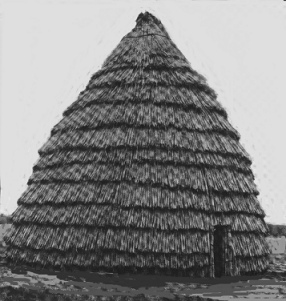 of
how big it is.
of
how big it is.
The Caddo would build
more than one house for a family group. They would build a house like above
for the winter and rainy weather. The Spanish sources tell us they would
also build another summer house next to the winter house. The summer house
had no sides on it, only a roof. The floor was special in the summer house.
The floor was raised up off the ground and was made of woven cane or split
wood. This woven floor was like a screen, it had small openings between
the wood to let air pass through. This floor and the open sides were all
to help keep cool in the hot humid East Texas Summers.
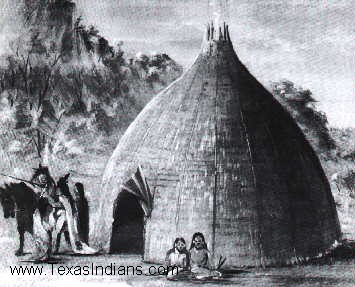
This is a Wichita hut
drawn by George Catlin. It looks like a Caddo hut, but it is much smaller.
Notice the pole frame and the grass covering. It may be covered with woven
grass mats.
FOOD.
They were farmers.
They planted crops in large clearings in the woods. They raised corn, beans
and squash. They also hunted the deer, turkey, rabbits, squirrels and other
animals in the pine woods around them. The women would gather wild plant
food like acorns, black berries, persimmons, roots and many other plants
and fruits. But, farming corn, beans, and squash provided the main source
of food. Hunting parties of men would be formed to travel west onto the
Southern Plains were there were many buffalo at certain times of the year.
This was a long trip that could take several weeks. The men would dry the
buffalo meat to preserve it so they could carry it home. They also saved
the valuable buffalo skins to tan and use as robes. Buffalo skins with
the hair on them are very soft and warm.
For food these Indians
farmed corn, beans, squash and other crops. They would also hunt deer and
gather berries, roots, and nuts. Early European explorers reported finding
the woods cleared like a European park. This means the grass was short
and the undergrowth was cleared away. The Indians did not have tractors
or lawn mowers to do this. They would set fires in the woods to burn away
the old taller grass and small shrubs and bushes without hurting the old
trees with thick bark. If this is done every year or so, the fire keeps
the undergrowth out. The Indians would do this in the fall and winter.
In the spring new green grass would get more sun and grow better on the
burned areas than in undergrowth. This tender green grass would attract
deer and animals to hunt. These fires also made it easier to find acorns
and nuts on the ground. The Southeastern Indians used a lot of acorns for
food. So these fires were useful and not destructive. This is one way the
Indians controlled their environment.
Go here to the Alabama-Coushatta page to read a Myth about how the Indians
got fire while gathering acorns. Read about the Alabama-Coushatta religion
while there because the Caddo religion was almost the same.
Here is a clever Caddo
myth about making corn meal. Thanks to Jane Archer and Wordware Publishing
for sharing it with us.
Corn Mill Coyote
from Texas Indian Myths and Legends
by Jane Archer
A woman pounded corn
in a favorite corn mill made from a tree trunk. Smooth with age, it was
about two feet wide and three or four feet tall. She dropped corn inside
and pounded it with a pole into fine meal.
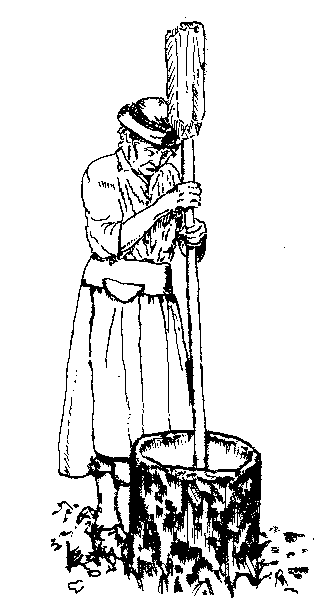
This is a Cherokee woman
using a corn mill just like a Caddo corn mill. Picture by R. E. Moore.
Editor's note, TexasIndians.com added this picture to Jane Archer's myth
so you could see what a corn mill looks like. Now back to the story.
As she pounded she noticed
the corn disappeared faster than meal was ground. She pounded harder and
faster, but she still lost more corn than she made meal. After pounding
all her corn, she gathered her small portion of meal.
She waited for the next woman to pound her corn to see if the same thing
happened. This woman pounded her corn but made very little meal. Now both
were suspicious. They waited for the next woman. She pounded her corn,
then gathered a small amount too. Now three women waited to watch the next
one. This woman pounded and pounded, but the corn disappeared and little
meal replaced it.
They discussed the situation, then decided something must be wrong with
the corn mill. They turned the mill this way and that, and then realized
it was not the same old mill they always used. Copyright, 2000, Jane Archer
One woman called for an axe to split the mill in half so they could see
inside. As a woman ran to get it, the mill fell on its side and rolled
around on the ground. The women jumped back in astonishment.
Coyote leaped up from what had been the corn mill and ran away.
All the women laughed. Now they understood that Coyote had hidden the old
corn mill and then turned into a mill to eat all their corn.
Copyright,
2000, Jane Archer
If you enjoyed this myth,
read more in Texas
Indian Myths and Legends by Jane Archer. Ask your librarian
to order Texas Indian Myths and Legends for your school.
Did you like that myth?
To learn more about Indian myths and for activities using myths check out
our Indian Myths
page.